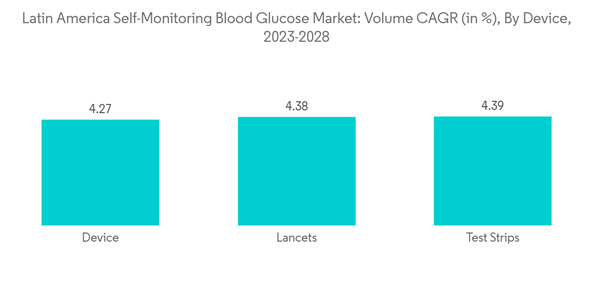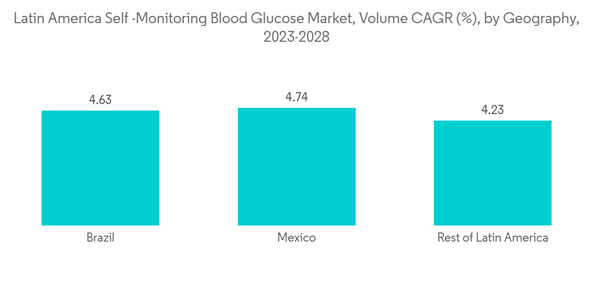Diabetes incidence for type 2 diabetes and other diabetes forms was numerically higher in individuals with Covid-19 in North America. Insulin resistance and impaired insulin secretion have been reported in people who recovered from SARS-CoV-2 infections but had no history of diabetes. It has been suggested that integrated rather than disease-specific approaches are required for the diagnosis and treatment of post-Covid syndrome.
Diabetes is common in Latin American countries, and Mexico is known to have a large number of diabetic patients due to the country's increasing prevalence of Type-2 diabetes. The steadily increasing obesity rate, combined with a genetic predisposition to Type-2 diabetes, has been a major driver of the increase in the Type-2 diabetic population over the last 40 years. Diabetes currently affects nearly 10% of the total population. Type 2 diabetes is the most prevalent type of diabetes in Latin America, accounting for nearly 90% of the total diabetic population in 2021. Argentina, Brazil, Colombia, and Mexico achieved an overall index of essential coverage of 76-77 percent, with households spending less than 25% of their income on health care, according to Universal Health Coverage 2022. Several reports and surveys have documented a significant increase in the diabetic population because of lifestyle and habit changes. The growing diabetic population drives the demand for blood monitoring devices like the SMBG. A glucometer is used by nearly 90% of Type 1 diabetic patients in developed countries. Glucometers are expected to be used by nearly half of Type 2 patients during the forecast period. Access to primary healthcare systems and noncommunicable disease coverage improved service coverage, while an increase in the number of qualified healthcare personnel enabled community outreach.
Therefore, owing to the aforementioned factors the studied market is anticipated to witness growth over the analysis period.
Latin America Self -Monitoring Blood Glucose Market Trends
Blood Glucose Test Strips Held the Largest Market Share in the current year.
Blood glucose test strips will account for approximately 79% of the Latin America SMBG market in the current year. The Glucometer is a one-time investment. The Glucometer is a one-time investment. Test strips, on the other hand, are a continuous investment because they must be discarded after one use. Test strips, on the other hand, are an ongoing investment. As a result, it has a significant cost impact on consumers. Overall, demand for blood glucose test strips will rise significantly during the forecast period. The growing diabetic population is expected to drive the market's growth. While the average glucose meter lasts six months and three years, resulting in a one-time cost, the corresponding use of multiple (thousands) test strips may occur during the same period, resulting in a recurring cost impact.The COVID-19 pandemic emphasized the importance of excellent glycemic control in diabetic patients, partly because most observational studies have found that poorly controlled diabetes is associated with an increased risk of hospitalization and mortality from a viral disease. Diabetes mellitus has sparked widespread concern due to its rising global prevalence, which has resulted in increased costs for healthcare systems, individuals, and governments. Industry participants use various methods to improve market share, including collaborations, partnerships, mergers, acquisitions, and expansions.
The rise in national awareness of diabetes is anticipated to drive the adoption of both SMBGs and CGMs on account of the prognostic and diagnostic treatment of diabetes.
Brazil is Expected to Dominate the Latin America Self-monitoring Blood Glucose Market.
The MOH governs the Brazilian health system, which each state and local health secretariat manages. Furthermore, in many towns where the public sector cannot meet people's needs, partnerships with private organizations have been established to increase access to PHC. Several programs in the Brazilian health system cover medicines, including a 20% increase in access to essential medicines. Brazil offers a comprehensive free immunization program. Over the last two decades, Brazil has faced many lawsuits demanding that high-priced drugs used to treat diabetes and other rare or low-prevalence diseases be covered. Between 2017 and 2045, the diabetic population in Brazil is expected to increase by 74%. Brazil is currently the sixth most populous country in the world, with the fourth highest prevalence of diabetes. To reduce the country's death rate, the Brazilian government is encouraging diabetes patients to take medication. The Brazilian Ministry of Health collaborated with private pharmacies in Brazil to provide free insulin (regular human insulin and isophane insulin or NPH) and three oral diabetes medications (5 mg glibenclamide and 500 and 850 mg metformin).The self-monitoring blood glucose devices are garnering widespread adoption due to the availability of reimbursement options for glucose meters. Glucose meter devices must be replaced within six to eight months, which is very expensive. As a result, most people prefer health insurance plans that cover most of their total expenditure on healthcare devices. Such schemes cover the costs of diabetes testing supplies, test strips, and blood glucose meters.
The growing awareness among people regarding advanced diabetes care products may positively impact Latin American Self-Monitoring Blood Glucose Devices in the coming years.
Latin America Self -Monitoring Blood Glucose Industry Overview
The Latin America self-monitoring blood glucose market is fragmented, with a few major manufacturers having a global market presence. In contrast, the remaining manufacturers are confined to local or region-specific manufacturers. Mergers and acquisitions that occurred between the players in the recent past have helped companies strengthen their market presence.Additional Benefits:
- The market estimate (ME) sheet in Excel format
- 3 months of analyst support
This product will be delivered within 2 business days.
Table of Contents
Companies Mentioned (Partial List)
A selection of companies mentioned in this report includes, but is not limited to:
- Abbott Laboratories
- F. Hoffmann-La Roche AG
- Platinum Equity (LifeScan)
- Arkray
- Ascensia
- Agamatrix Inc.
- Bionime Corporation
- Acon
- Medisana
- Trivida
- Rossmax
Methodology

LOADING...










